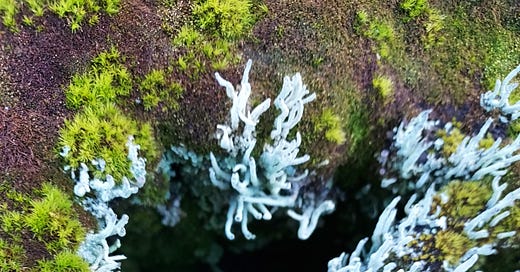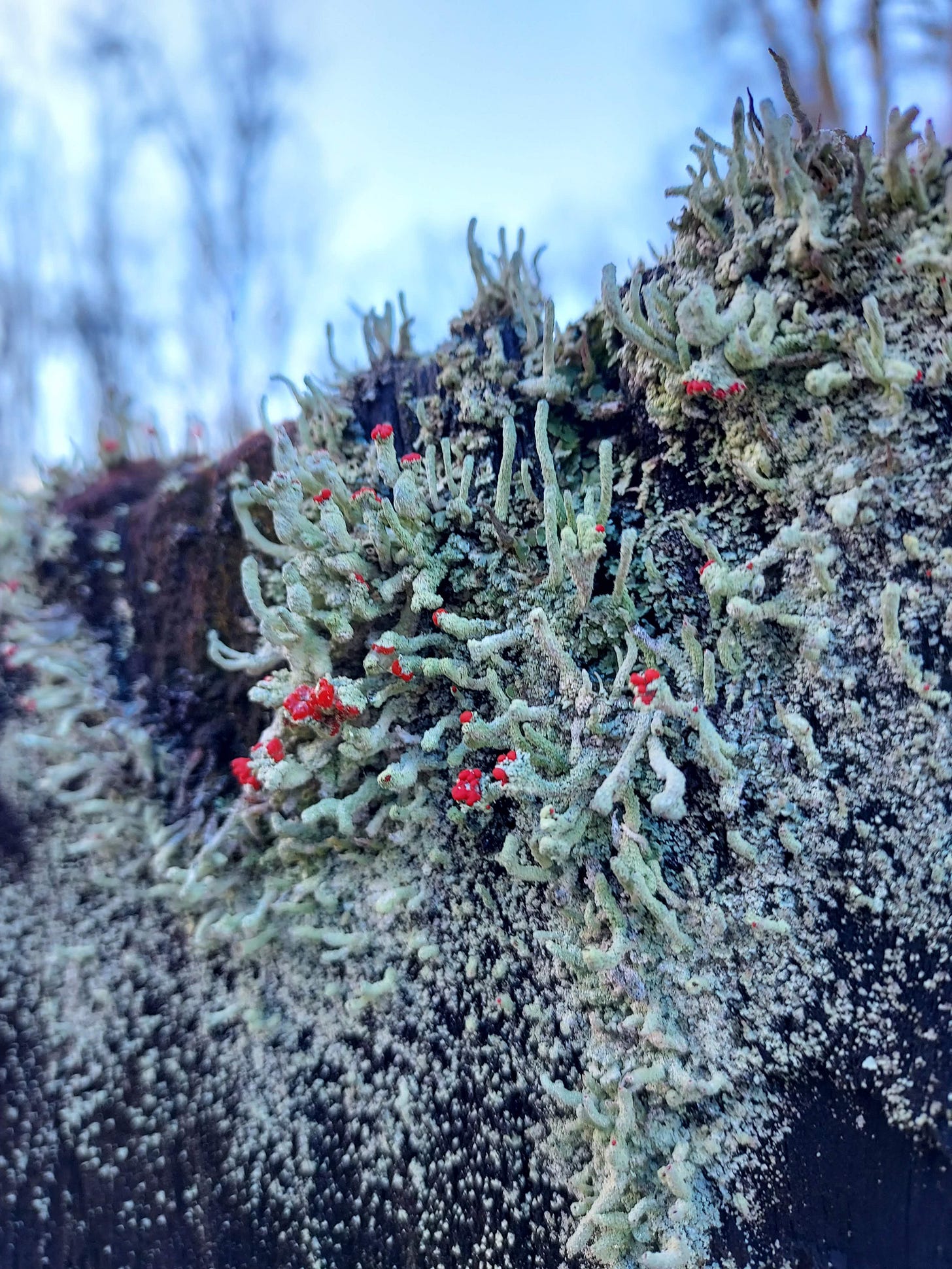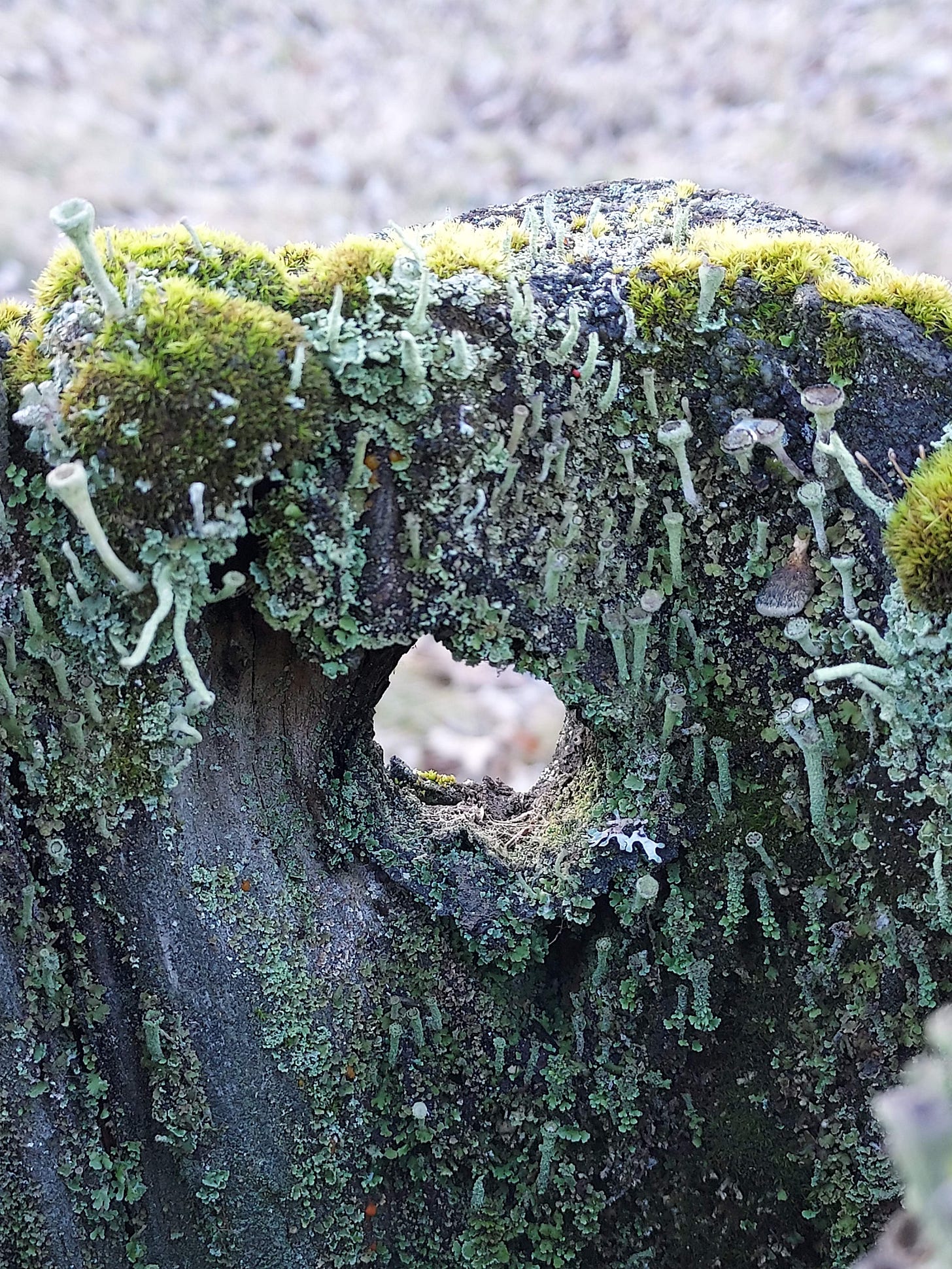I have two classes actively enrolling: Climate Journaling in the End Times, offered on the first Tuesday of the month through Corporeal Writing; and Speculative Shorts, a fiction workshop focusing on the short & weird. Both are online & sliding scale.
How would lichen confront a challenge?
slowly, bit by bit
by changing the atmosphere
by making a city of itself
by knowing where not to grow
by tending the gardens of its relationships
by covering time
by creating its own architecture of decoration
An architecture of decoration is very different from decorative architecture. Decorative architecture means a building or edifice embellished with flourishes to please the eye; the underlying foundation is still solidly engineered, precise angles topped with icing. It could also mean architecture intended to create an illusion, i.e. false facades on buildings meant to make them look a certain way or bigger than they are.
Meanwhile, an architecture of decoration is flimsy, whimsical, no foundation whatsoever undergirding the decoration. The decoration is the whole point.
Is an architecture of decoration harder to topple? In many ways the answer is yes; it’s more delicate, easy to be stomped upon. Lichen doesn’t grow very tall. But this is its advantage. I once imagined what lichen might say to a tree:
“Look, you could develop a whole vascular system on your own and make a go of it, reaching for the sky and the sun, standing as tall as possible. Or you could embark on an uneven partnership and stay low to the ground, out of notice, two players better known for darkness and decay making an attempt at life on land. We’ll never know what it’s like to announce ourselves as resource like a tree, or what it feels like to branch out and dance in the wind, but we also won’t make ourselves available for betrayal by humans for whom we’ve patiently grown magnificent breathing palaces only to see them leveled in one clear swath.”
Knowing, too, that lichen were not progenitors of trees, but rather were an experiment by plant life having already migrated to land, taking a look around, reading the writing on the wall, and opting to return to the sea and try again with different partners, different body plans—it’s easy to imagine lichen holding onto this secret in their cells to talk back to scientists, to say hang on, we didn’t colonize anything. the beginning of life on land is your own problem to fix.
I was hoping to have a new blog up and running by now. I’m not deleting this newsletter, but I’ve grown tired of the same old media ecosystem growing up around Substack as we saw with twitter and instagram and all the others. I want a place on the internet I can grow with instead of against or in spite of. I want an online place that doesn’t actively fight the archive by caring more about what’s next. Maybe that’s impossible now, but I think there’s still time to try and figure it out.
Just before the end of 2024, I had a dream: I was driving along a stretch of highway that looked very similar to interstate 91 as it traces the border between Vermont and New Hampshire. It was a road I used to drive frequently. In my dream, I had to stop the car; there may have been a line of cars stopped zombie-movie style, there may have been nothing other than a feeling. I only remember that I couldn’t go on, despite the fact that the GPS indicated that I should. I got out of the car and hiked up a short rise and saw that a gigantic rift had opened up in the earth. I couldn’t see an end to the rift it was so long, and the bottom was obscured in darkness. It was several hundred yards across and there was no way to get around it. People had gathered near its edge, and they’d begun erecting beautiful sculptures and columns and small areas of creative worship. It wasn’t clear if this adoration was strictly meant for the rift, but it was clear that it had been there for some time and I somehow hadn’t noticed.
If you’re in the Portland area, I’ll be reading with writer & friend Miranda Schmidt on April 3rd at Up Up Books. Miranda is another writer who’s deeply engaged in questions of inheritance and responsibility and nonhuman love in a precarious time, and if you enjoy my newsletter, then I’m sure you’ll enjoy their debut novel Leafskin. We’ll be joined by poet, musician, and former park ranger Justine Chan, so you know it’s going to be an incredible evening <3
Finally, have you checked out the 11th issue of smoke and mold, entirely themed around Disability Justice?? If not, go do so now! In particular, this essay by M.K. Thekkumkattil about being a trauma nurse as a queer brown person in Alaska really transformed for me how I look at healthcare:
I see sepsis as femme, sepsis as hysterical, sepsis as a queer death drive. A body, trying to protect itself, endangers its future. To be alive is not always the best option for our infected bodies. The body’s natural response to threat is to self-destruct.
But we keep our issues small to encourage readers to engage with every piece. So you should spend some time over there.







